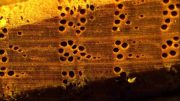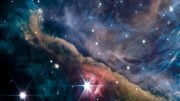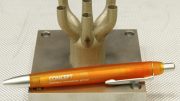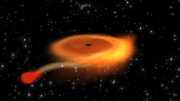
A far-infrared dust map of the star formation region in Orion showing protostellar candidates (of various types) with very low extinction using blue and green markers. The background color corresponds to the infrared brightness; the black line represents one survey region. Astronomers have confirmed that ten of these candidate objects are true protostars even though, contrary to expectations, they are not deeply buried within their clouds.
New research from the Harvard-Smithsonian Center for Astrophysics concludes that ten protostellar candidates are indeed protostars even though they are not presently embedded in a cloud.
Stars form as gravity contracts the gas and dust in an interstellar cloud until clumps develop that are dense enough to coalesce into stars. Precisely how this happens, however, is very uncertain, and the processes are hard to study because they occur inside the opaque interiors of these clouds. The number of stars that form from a single clump is not well understood, for example, nor are the stellar masses. In the earliest stages of formation, the so-called protostellar stage, the newborn star is still accreting material from an envelope and is ringed by a circumstellar disk (which can develop into a system of planets). This earliest stage, which occurs when the star is the most heavily obscured, is therefore also the most mysterious.
Infrared observations can penetrate the dust in a stellar womb, at least partially, with the reddest wavelengths being least obscured. Astronomers examining Spitzer Space Telescope infrared images of the Orion star-forming complex discovered 329 protostars in the region, and forty-four of them did not appear to be very red — and hence not deeply embedded, contrary to expectations. CfA astronomers John Lewis and Charlie Lada wondered how that could be. After re-examining the dataset with more stringent criteria, they concluded that only ten were true protostars, with the others being extragalactic objects and nebulous regions with a few unclassified sources. But these ten were still ten more than would be predicted.
The astronomers modeled these ten protostars (including for their analysis a variety of other data) and concluded that indeed they are protostars … and they are not presently embedded in a cloud. The scientists dub them “orphan protostars,” and speculate that they have left their nursery at a young age, perhaps ejected in a gravitational interaction with a more-massive sibling. Alternative possibilities include that they just migrated away, or that somehow they were able to dissipate their immediate surroundings through winds. Additional research will narrow these choices. On the one hand, these new results make the class of protostars even more varied, but on the other hand, they confirm that the general theory is steadily improving even though the range of conditions has increased.
Reference: “Protostars at Low Extinction in Orion A” by John Arban Lewis and Charles J. Lada, 6 July 2016, The Astrophysical Journal.
DOI: 10.3847/0004-637X/825/2/91
arXiv:1605.02732









Be the first to comment on "Astronomers Reveal ‘Orphaned Protostars’"